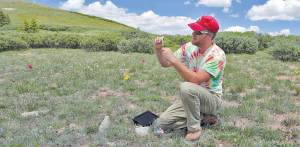by John Mattingly
In my last two columns about the beef business, I discussed the cow-calf end of the supply chain, explaining how feedlot operations benefit from the various subsidies enjoyed by cow-calf ranchers. My basic claim is that the foundation of the beef business, the cow-calf operation, is financially irrational. The beef business persists only with outside income sources, benefits from inheritances, utilization of tax advantages through asset depreciation, and in some cases the equivalent of a “social grant” by way of a conservation easement or open space subsidy.
The feedlot operators and packers then set the price for the product of the cow-calf operations: feeder calves. They do so based on their costs of operation; most feedlot operators utilize the futures markets, which effectively gives them substantial market share – leaving the cow-calf producer with a large capital investment terminally susceptible to the vague mercies of the market.
If the reader still thinks beef is good for dinner, you might want to visit a Great American Feedlot. Keep in mind that feedlot residents are mostly castrated bull calves which were likely raised on open range and green pastures by family ranchers who cared for them with a personal touch, subsidizing the life of that calf extensively. These calves are suddenly shipped to market in a truck and then confined to pens and fed a ration that graduates to more and more corn and “concentrate” that finally “finishes” them. This term is true in both senses of the word: the animals are indeed finished. As soon as they reach about 1,200 pounds, they are killed and end up in the supermarket.
Thinking about this from the calf’s point of view, the creature lives in a somewhat pastoral world of grass and mother cows for about a year, seeing an occasional person, or horse, or deer and elk, grazing and nursing with its mother. Then, abruptly, the yearling is placed in a pen with other cattle, given a bunch of shots, and stands in its own manure and waste for five or six months eating corn, a combination that is so toxic that feedlot animals are typically fed a prophylactic level of antibiotics and given shots for overeating and acidosis.
To understand this, it’s necessary to provide a short anatomy reminder. Bovines are ungulates. They have four stomachs. The first stomach, the rumen, is a large vat of bacteria that digests the fiber and complex carbohydrates of the various forages they consume. The rumen separates liquids from solids, and ruminants regurgitate the solids as boluses of fiber to re-chew several times, usually in repose after they have grazed.
We sometimes use the word “ruminate” to describe government officials in comfortable positions lying around in their offices, and also to put a fine point on the conduct of a person who is just lying around chewing their thoughts the way cattle chew and re-chew the fiber they have eaten. When ruminants regurgitate, and flatulate from the anus, they produce methane, the gas produced as an exudate of bacterial digestion in the rumen. Methane is a greenhouse gas on steroids, meaning ruminant animals, including goats, sheep, deer, elk, antelope and all ungulates produce a lot of what we now understand as greenhouse gas pollution.
The rumen is, in a word, extraordinary. It evolved to do this process of digestion, regurgitation, re-chewing and re-digestion of complex fibers such as grass and other forages that most mammals cannot digest. The rumen did not evolve to consume simple carbohydrates, aka “concentrates” such as corn, which require very little bacterial activity to break down. In fact, corn in any quantity digests so rapidly that the bacteria in the rumen produce an excess of acidic by-products that are toxic to the animal, and many feedlot beef animals have abscesses on their organs, particularly the liver, which is why you rarely see fresh beef liver and other organ meats in supermarket meat sections these days.
The second stomach, the reticulum, is a small pouch to the side of the rumen, designed to receive any foreign objects the ruminant might accidentally consume, such as a piece of wire or chunk of metal. It was common – in the days when wire-tie balers were still in use – for cattle to inadvertently consume small pieces of wire that resulted from a flaw in the design of the baler’s wire-twisting mechanism. These small wire pieces built up in the second stomach, the reticulum. When enough metal built up in the reticulum, the creature became weak and looked poorly, walking with a pronounced slump, giving the appearance of being “down in the back” and was said to be “carrying hardware.”
The third stomach, the omasum, acts like a huge wringer, squeezing the liquid out of the fiber and sending it along to the fourth stomach, the abomasum, where the nutrients are absorbed into the blood system. It’s a marvelous evolutionary endowment capable of digesting complex carbohydrates, which has been dubiously expanded by humans for the benefit of mass beef consumption.
The beef industry tucks neatly into the corn and soybean monocultures now ever-present in our nation’s breadbasket. And, of course, it is well understood that consumption of large quantities of red meat is not particularly well adapted to the human digestive system, nor to long-term human health.
Like the peculiar persistence of the cow-calf business despite its financial shortcomings, the continuing dominance of the red meat industry in America also begs for theories explaining its persistence when it is not healthy for either the consumer or the comsumed.
First, following WWII, most Americans became conditioned to meat as the central feature of a meal. Maybe it was compensation for the hardship of the War, and the Great Depression that preceded it. Or again, to our hunter-gatherer ancestors, meat was a luxury, gained with effort and risk, so having a domesticated supply of meat is associated with security and wealth. Many explanations are possible, but it is clearly true that as nations became affluent following the Industrial Revolution, they consumed more meat. It’s an evolutionary privilege to eat from the top of the food chain and we have learned tasty ways to do so.
Preference for meat may even be a sequencing in the evolutionary imperative of human mammals to grow a bigger brain, made possible in large part by the consumption of animal protein. Humans seem to be biologically wired to want to eat meat when they have the resources to do so. There is no doubt that animal protein accelerated human dominance of the planet, though it was primarily sheep and goat meat, not beef that enabled this growth. Bovines were first used as beasts of burden, too valuable in that capacity to be eaten.
Second, during the first OPEC oil embargo in the winter of 1973, oil jumped from about a dollar a barrel to twelve. This instantly changed the world’s relationship to energy. At a dollar a barrel, the cost of energy in agriculture was almost negligible.
I farmed during that period, and I recall the shock when diesel, delivered to my bulk tank on the farm, jumped from about ten cents a gallon to twenty-five cents. Farmers were outraged, and like most Americans, that period of cheap energy gave us a sense of being entitled to cheap energy and thus cheap food, because food production is a high-energy business.
After the 1973 OPEC embargo, commodity prices shot upward. I recall pinto beans going from seven dollars a hundredweight to sixty. Sugar beets went from twenty dollars a ton to seventy, and corn and barley and wheat jumped up several hundred percent. This caused a real scare to the Nixon administration. Nixon understood that cheap food was essential to a growing economy and a happy constituency. Accordingly, when Earl Butz suggested that U.S. farmers be encouraged to “feed the world” and farm “fencerow to fencerow!”, Nixon authorized it.
Prior to this change, most U.S. farmers were indeed paid not to produce. But that characterization is a bit misleading, because farmers weren’t being paid to not grow a crop; it was a payment for setting aside about twenty percent of the farm’s cropland each year, meaning that all participating farms received a subsidy to fallow one-fifth of their cropland each year. It was optional, and it was a good system. I farmed through it, and it was a great idea. It enabled farmers to rest a portion of their land each year, and grow a variety of crops in rotation, often with livestock in the mix for returning manure to the land.
With the new Nixon-Butz program, however, there was no set-aside acreage. Instead, the federal government established an annual “target price,” aka “support price,” for all major commodities and guaranteed farmers the support price. Instead of “paying farmers not to produce,” the new program essentially paid farmers to overproduce. Commodity prices were high at the time the decision was made to do away with the “old set-aside program,” which was an easy sell to the public, because why pay farmers to set aside land that could be cranking out cheap food? However, prices promptly declined when mountains of surplus corn and soybeans were produced in the years immediately following, the mid-to-late 1970s. The surplus commodities created by the fencerow-to-fencerow price support policy had to go somewhere, and this is the period in which feeding livestock in confinement literally exploded on the rural landscape.
Corn and soybeans produced in abundance with a government price guarantee led to a monocultural approach to farming in the U.S. breadbasket. Instead of a crop rotation of corn, soybeans, alfalfa, pasture, vegetables, orchard or other crops, chemical companies saw the opportunity to give farmers a cocktail of toxic materials that allowed corn and soybean production to continue on the same ground year after year. This is a long, long story, with the ending that 90% of all SKUs in the typical U.S. supermarket today have either corn or soybeans in them, in some form or other. And corn and soybeans are being fed to cattle, hogs and chickens in massive confinement operations.
Feedlot beef was perhaps one of the first big confinement sectors to take advantage of cheap corn and soybeans. This economic windfall plugged in to the fast food industry, and away we go. Most U.S. consumers are eating a lot of corn and soybean products that are genetically altered while awash in pesticides, and they don’t even know it. Health problems related to this abound, although given the anti-science attitudes that dominate much of the rural U.S. and lawmakers, there is no suggestion on the horizon that substantial change is coming.
Finally, the persistence of the feedlot industry in the U.S. is now largely a function of momentum. The triangle of farmers, chemical companies and food distributors is well-established, concentrated and well-funded. Consumers are largely complacent, diffuse, and, on balance, not storming the fortress demanding cleaner, healthy food. When Michelle Obama attempted to mandate healthier food in elementary schools, she was fire-bombed by the fast food and snack industries.
As indicated in a prior column, consumers have a lot of power, but their diffuse nature weakens the effect. It will take either a calamity of some sort, or a major shift in consumer preferences, to cause the beef industry to make changes.
Takeaway for the home shopping list: beef, in particular, is not a good choice for dinner.
John Mattingly cultivates prose, among other things, and was most recently seen near Poncha Springs.




I love your writing john!
So, there is a little ditty circulating on fb now claiming you wheat farmers douse the wheat in Roundup right before harvest to make it easier to “cut”. Personally I think this is bs, but know you would set me straight, so here I am asking?
They don’t really do that do they? I personally can’t follow the logic of it myself?
http://www.thehealthyhomeeconomist.com/real-reason-for-toxic-wheat-its-not-gluten/
Please advise. Thanks! Polly